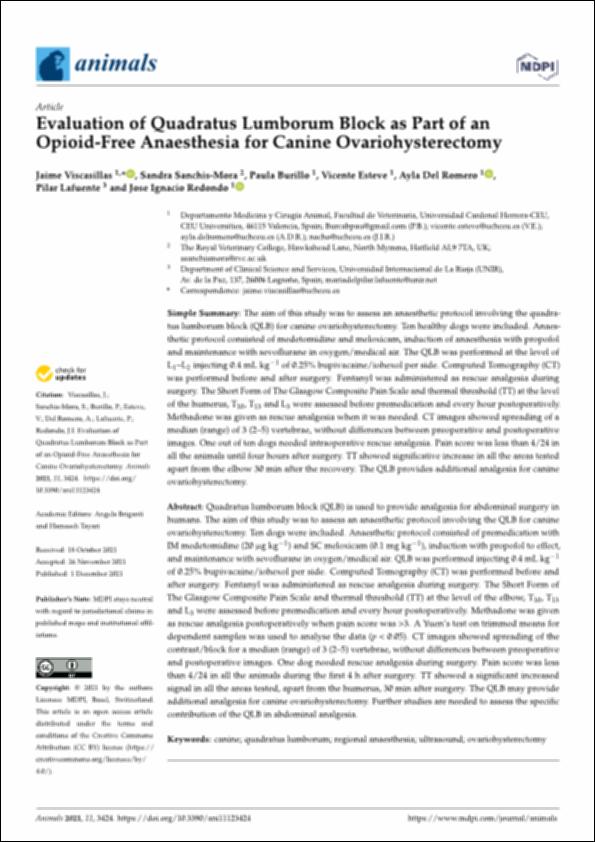Please use this identifier to cite or link to this item:
http://hdl.handle.net/10637/13454Evaluation of quadratus lumborum block as part of an opioid-free anaesthesia for canine ovariohysterectomy
| Title: | Evaluation of quadratus lumborum block as part of an opioid-free anaesthesia for canine ovariohysterectomy |
| Authors : | Viscasillas Monteagudo, Jaime Sanchis Mora, Sandra Burillo, Paula Esteve Bernet, Vicente Romero Martínez, Ayla del Lafuente Baigorri, Pilar Redondo García, José Ignacio |
| Keywords: | Perros - Aparato genital - Cirugía.; Dogs - Generative organs - Surgery.; Anestesia veterinaria.; Veterinary anesthesia.; Ovaries - Surgery.; Dogs - Anesthesia.; Anestesia local.; Local anesthesia.; Ovarios - Cirugía.; Perros - Anestesia. |
| Publisher: | MDPI |
| Citation: | Viscasillas, J., Sanchis-Mora, S., Burillo, P., Esteve, V., Del Romero, A., Lafuente, P., & Redondo, J.I. (2021). Evaluation of quadratus lumborum block as part of an opioid-free anaesthesia for canine ovariohysterectomy. Animals, vol. 11, i. 12 (01 dec.), art. 3424. DOI: https://doi.org/10.3390/ani11123424 |
| Abstract: | Quadratus lumborum block (QLB) is used to provide analgesia for abdominal surgery in humans. The aim of this study was to assess an anaesthetic protocol involving the QLB for canine ovariohysterectomy. Ten dogs were included. Anaesthetic protocol consisted of premedication with IM medetomidine (20 g kg1) and SC meloxicam (0.1 mg kg1), induction with propofol to effect, and maintenance with sevoflurane in oxygen/medical air. QLB was performed injecting 0.4 mL kg1 of 0.25% bupivacaine/iohexol per side. Computed Tomography (CT) was performed before and after surgery. Fentanyl was administered as rescue analgesia during surgery. The Short Form of The Glasgow Composite Pain Scale and thermal threshold (TT) at the level of the elbow, T10, T13 and L3 were assessed before premedication and every hour postoperatively. Methadone was given as rescue analgesia postoperatively when pain score was >3. A Yuen’s test on trimmed means for dependent samples was used to analyse the data (p < 0.05). CT images showed spreading of the contrast/block for a median (range) of 3 (2–5) vertebrae, without differences between preoperative and postoperative images. One dog needed rescue analgesia during surgery. Pain score was less than 4/24 in all the animals during the first 4 h after surgery. TT showed a significant increased signal in all the areas tested, apart from the humerus, 30 min after surgery. The QLB may provide additional analgesia for canine ovariohysterectomy. Further studies are needed to assess the specific contribution of the QLB in abdominal analgesia. |
| Description: | Este artículo se encuentra disponible en la siguiente URL: https://www.mdpi.com/2076-2615/11/12/3424 Este artículo pertenece al número especial "Loco-Regional Anaesthesia in Veterinary Medicine". |
| URI: | http://hdl.handle.net/10637/13454 |
| Rights : | http://creativecommons.org/licenses/by/4.0/deed.es |
| ISSN: | 2076-2615 (Electrónico) |
| Issue Date: | 1-Dec-2021 |
| Center : | Universidad Cardenal Herrera-CEU |
| Appears in Collections: | Dpto. Medicina y Cirugía Animal |
Items in DSpace are protected by copyright, with all rights reserved, unless otherwise indicated.


